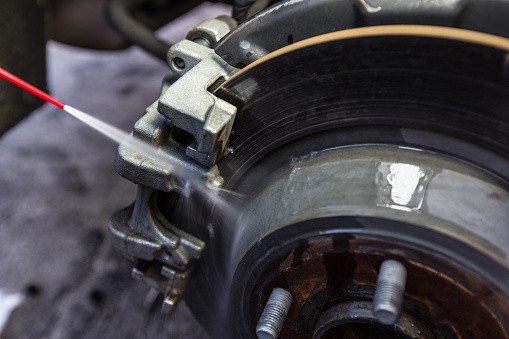Most people may never think about getting their brake calipers cleaned until they have a full brake service where the calipers are disassembled. However, there is another way you can clean your brake calipers if you suspect that there is rust or dirt in them that’s impacting their performance.
Below you’ll find an overview of how to clean brake calipers without removing them from your car. This method can correct minor brake caliper issues caused by debris build-up. Read on to learn more about how to clean your brake calipers without having to take them off your car.
Supplies for Cleaning Brake Calipers
Before you start cleaning your brake calipers, you’ll need some basic supplies to get the job done. Here is a rundown of the things that you should gather to get started.
Wire Brush
When you have minor debris or rust on your brake calipers, using a wire brush on them can help agitate any brake cleaner you spray and dislodge debris. This cleaning allows your calipers to operate more smoothly.
Silicone Lubricant
Silicone lubricant is spread on the brake calipers to help soften any friction between the caliper pistons and the brake pads. Without proper lubrication, heat build-up during brake operation can cause the brake pads to break down faster. Silicone lubricant is best for lubricating hydraulic mechanisms.
Molybdenum Disulfide Lubricant
Molybdenum disulfide lubricant is useful in caliper cleaning for lubricating any area that experiences metal-on-metal friction. This can help prevent the calipers from warping over time.
Small Toothbrush
A wire brush is best for cleaning the larger parts of the brake calipers, but a small toothbrush can help you get brake cleaner down into the nooks and crannies of the calipers without having to take them off the car.
Tools for Removing the Tire
Along with the tools and supplies you’ll need to address the brake caliper directly, you’ll also need a lug wrench, a jack, and any other tools you may need to get the tire off the car. While you can clean your brake calipers thoroughly without removing them, you’ll need to remove the tire to access them.
Brake Cleaner
Brake cleaner is the best solution for removing rust, dirt, and old grease from your brake calipers. Most of these cleaners are aerosol sprays designed to coat the surface of the calipers evenly.
Once you have the tools and supplies above together, you’re ready to get started cleaning your brake calipers.
Remove the Wheel to Access the Brake Calipers
Even though you don’t have to remove your brake calipers to clean them, you will need to remove the wheel to get access to them.
To remove the car wheel, follow these steps:
- Park the car on a firm, flat, level surface
- Lift the car’s wheel up off the ground using a car jack
- Use a lug wrench to remove the lug nuts on the wheel to loosen it.
- Slide the tire off the car, giving you access to the brake system on the wheel compartment’s interior.
Now that you have access to the brake calipers, let’s move on to the next step.
Locate and Inspect the Caliper
The brake caliper in most cars is inside the wheel and can be found attached to the master cylinder of the brake system. If you’re unsure where the brake caliper is on your vehicle, consult the owner’s manual and it should point the component out in a diagram.
Once you’ve located the brake caliper, you can do an inspection of it. To do so, perform the following:
- Do a visual inspection. This inspection is to see if there is any visible debris or rust built-up on the caliper, or any physical wear and tear.
- Turn the wheel assembly by hand. If the wheel assembly is difficult to turn or gives resistance, this is an indicator that the caliper is sticking and holding the brake pad to the rotor during wheel operation.
If you encounter resistance during the wheel turn test, the problem might be resolved by a thorough cleaning and lubrication of the brake caliper. This solution should be attempted before replacing the caliper itself, which can be quite expensive.
Add Brake Cleaner to the Caliper
After inspecting the calipers, the next step in cleaning them is adding brake cleaner. It’s essential to follow the instructions on the brake cleaner carefully, as each brake cleaner is different and has different rules for application.
Most brake cleaners are spray products and should be sprayed liberally across the surface of the brake caliper. Give the brake cleaner a few minutes to penetrate any rust or grime before using a wire brush and toothbrush to agitate the surface of the calipers and dislodge any remaining debris.
Once you’ve cleaned the brake calipers, use a cloth to wipe away any remaining brake cleaner.
Lubricate the Brake Caliper
The final step after cleaning your brake calipers is to lubricate them. Lubrication is vital in car systems because it helps prevent the wear and tear of components over time. Silicone lubricant is a good idea for lubricating the caliper’s slide pins, while molybdenum lubricant is recommended for areas of metal-on-metal friction.
Along with applying lubricant to the caliper piston, it’s also recommended that you lubricate the brake pad where it encounters the caliper.
Cleaning Brake Calipers Isn’t Complicated
It can be a little challenging to do a full brake job on your car if you’re unsure how to properly bleed brakes and adjust them. However, giving your brake calipers a good cleaning can be done easily and add thousands of miles of service to the parts.

